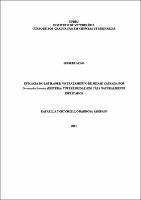| ???jsp.display-item.social.title??? |


|
Please use this identifier to cite or link to this item:
https://tede.ufrrj.br/jspui/handle/jspui/6818| ???metadata.dc.type???: | Dissertação |
| Title: | Eficácia do lotilaner no tratamento de miíase causada por dermatobia hominis (diptera: cuterebridae) em cães naturalmente infestados |
| Other Titles: | Efficacy of lotilaner in the treatment of myiasis caused by dermatobia hominis (diptera: cuterebridae) in naturally infested dogs |
| ???metadata.dc.creator???: | Sampaio, Rafaella Tortoriello Barbosa  |
| ???metadata.dc.contributor.advisor1???: | Fernandes, Julio Israel |
| ???metadata.dc.contributor.referee1???: | Bendas, Alexandre José Rodrigues |
| ???metadata.dc.contributor.referee2???: | Fernandes, Julio Israel |
| ???metadata.dc.contributor.referee3???: | Dutra, Ary Elias Aboud |
| ???metadata.dc.description.resumo???: | Larvas de Dermatobia hominis promovem lesões cutâneas conhecidas como dermatobiose. Estas são intensamente incômodas, dolorosas e a presença concomitante de infecções bacterianas e miíases acarreta no agravamento do quadro. Um tratamento eficaz deve eliminar ou matar as larvas existentes e promover a cicatrização da ferida o mais precoce possível. A extração manual de larvas por digito pressão é o método de tratamento mais empregado, entretanto, pode acarretar em intenso desconforto ao animal. Uma terapia segura, indolor e eficaz tem incentivado a busca de novas opções farmacêuticas. O objetivo deste estudo foi avaliar a eficácia de lotilaner no controle de D. hominis em cães naturalmente infectados. Para as avaliações foram utilizados 12 cães, sem raça definada, com idade entre um e dez anos de vida, de ambos os sexos, com peso variando de 10 a 20 kg, com no mínimo três larvas em cada, localizadas em qualquer região do corpo. Os indivíduos foram medicados com lotilaner, seguindo as recomendações de bula para o tratamento de outras ectoparasitoses, na dose mínima de 20 mg/kg, administrado por via oral em dose única. Após 6 horas foi realizada a retirada larval para verificar a atividade larvicida da medicação. As larvas que apresentassem um mínimo de motilidade após a remoção foram consideradas vivas. A eficácia do lotilaner, foi calculada pela seguinte fórmula: [100 x (número de larvas mortas - número de larvas vivas) / número total de larvas]. Totalizando 98 larvas, sendo, 19 larvas recuperadas vivas, representado uma eficácia de 80,6% após seis horas da administração do lotilaner. Ressalta-se que as 19 larvas recuperadas vivas apresentaram discreta motilidade, sugerindo que a eficácia poderia ser maior, caso a retirada fosse realizada em um período posterior. Conclui-se que o lotilaner administrado por via oral em dose única de 20mg / kg foi eficaz no controle de D. hominis em cães naturalmente infestados. |
| Abstract: | The human bot-fly cause skin limitations such as dermatobiosis. These are intensely uncomfortable, painful and the concomitant presence of bacterial infections and myiasis leads to aggravation of the condition. An effective treatment should eliminate or kill such existing larvae and promote wound healing as early as possible. Manual extraction of larvae by finger pressure is the most corrected treatment method, however, it can cause intense discomfort to the animal. Safe, painless and effective therapy has encouraged the search for new pharmaceutical options. The aim of the study was to evaluate the effectiveness of this lotilaner in the control of D. hominis in naturally infected dogs. For how we used 12 dogs, mixed breed, aged between one and ten years old, of both sexes, with variable weight from 10 to 20 kg, with at least three larvae in each, with at least three larvae in each, mandatory in any region of the body. The individuals were medicated with lotilaner, following the package insert recommendations for the treatment of other ectoparasitosis, at a minimum dose of 20 mg / kg, administered orally in a single dose. After 6 hours, larval removal was performed to verify the larvicidal activity of the medication. Larvae that showed minimal motility after removal were examined alive. The lotilaner efficacy was obtained by the following formula: [100 x (number of dead larvae - number of live larvae) / total number of larvae]. Totaling 98 larvae, 19 larvae recovered alive, representing an efficacy of 80.6% after six hours of lotilaner administration. It is noteworthy that as 19 larvae recovered alive, it dissipates motility, suggesting that the effective one could be higher, if the removal was carried out at a later period. It is concluded that lotilaner administered orally in a single dose of 20mg/kg was effective in controlling D. hominis in naturally infested dogs. |
| Keywords: | Berne Isoxazolina Larvicida Human bot-fly Isoxazoline Larvicide |
| ???metadata.dc.subject.cnpq???: | Parasitologia |
| Language: | por |
| ???metadata.dc.publisher.country???: | Brasil |
| Publisher: | Universidade Federal Rural do Rio de Janeiro |
| ???metadata.dc.publisher.initials???: | UFRRJ |
| ???metadata.dc.publisher.department???: | Instituto de Veterinária |
| ???metadata.dc.publisher.program???: | Programa de Pós-Graduação em Ciências Veterinárias |
| Citation: | SAMPAIO, Rafaella Tortoriello Barbosa. Eficácia do lotilaner no tratamento de miíase causada por dermatobia hominis (diptera: cuterebridae) em cães naturalmente infestados. 2021. 58 f. Dissertação (Mestrado em Ciências Veterinárias) - Instituto de Veterinária, Universidade Federal Rural do Rio de Janeiro, Seropédica, 2021. |
| ???metadata.dc.rights???: | Acesso Aberto |
| URI: | https://tede.ufrrj.br/jspui/handle/jspui/6818 |
| Issue Date: | 29-Sep-2021 |
| Appears in Collections: | Mestrado em Ciências Veterinárias |
Files in This Item:
| File | Description | Size | Format | |
|---|---|---|---|---|
| 2021 - Rafaella Tortoriello Barbosa Sampaio.pdf | 2021 - Rafaella Tortoriello Barbosa Sampaio | 2.33 MB | Adobe PDF |  Download/Open Preview |
Items in DSpace are protected by copyright, with all rights reserved, unless otherwise indicated.




